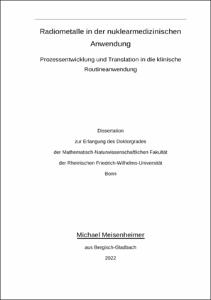Radiometalle in der nuklearmedizinischen AnwendungProzessentwicklung und Translation in die klinische Routineanwendung

Radiometalle in der nuklearmedizinischen Anwendung
Prozessentwicklung und Translation in die klinische Routineanwendung

| dc.contributor.advisor | Essler, Markus | |
| dc.contributor.author | Meisenheimer, Michael | |
| dc.date.accessioned | 2022-04-20T13:20:32Z | |
| dc.date.available | 2022-04-20T13:20:32Z | |
| dc.date.issued | 20.04.2022 | |
| dc.identifier.uri | https://hdl.handle.net/20.500.11811/9749 | |
| dc.description.abstract | In der vorliegenden Arbeit wurden mehrere Aspekte der täglichen radiopharmazeuti-schen Arbeit in der Nuklearmedizin bearbeitet. Der Fokus lag dabei auf der Translation von neuen Tracern aus der Forschung in die klinische Routine, insbesondere hinsicht-lich der Automatisierung von Synthesen.
Lange Zeit war der Bedarf an 68Ga-markierten Radiotracern und die Zahl der damit verbundenen Synthesen überschaubar. Häufig reichten wenige Synthesen pro Woche aus. Diese konnten in manuellen Verfahren durchgeführt werden, wenn der Strahlen-schutz gegeben war. Neue Tracer, insbesondere [68Ga]Ga-PSMA-11, haben zu einem erhöhten Patientenaufkommen, und damit verbunden, zu mehr Synthesen geführt. Hin-zu kommt, dass die Anforderungen, durch Strahlenschutz und GMP, über die Jahre zugenommen haben. Eine der großen Herausforderungen der klinischen Routine ist es aktuell dieser Nachfrage gerecht zu werden, ökonomisch zu arbeiten und dabei der Gesundheit des Personals und dem Schutz der Patienten Rechnung zu tragen. Module ermöglichen es, dass verschiedene Radiopharmaka mit robusten Synthesen und vor allem GMP-konformen Materialien bei geringer Dosisbelastung für das Perso-nal hergestellt werden können. Für die Entwicklung einer automatischen Synthese, ist das vorherige systematische Untersuchen der jeweiligen Radiometalltracer die Voraus-setzung. Darauf aufbauend konnte eine Standardsynthese etabliert werden, welche mit geringfügigen Anpassungen geeignet ist, um neue Tracer zügig für die Routine verfüg-bar zu machen. Dennoch ist das Implementieren, trotz dieser Vorarbeiten, nicht ohne Herausforderung. Für jeden Tracer und jedes Radionuklid müssen seine chemischen, aber auch physikalischen Eigenschaften bedacht und berücksichtigt werden, um die Qualität des Produktes gewährleisten zu können. Zusätzlich können nicht immer alle auftretenden Probleme zufriedenstellend gelöst werden. Schlussendlich konnten mehrerere neue Tracer automatisiert werden. Die Automatise-rung, aber auch die dazugehörige Qualitätskontrolle, wurde hinsichtlich ihrer optimalen Parameter evaluiert und für die Routine validiert. Die Tracer konnten dann erfolgreich in der klinischen Anwendung weiter evaluiert werden. | en |
| dc.description.abstract | In the present work, several aspects of daily radiopharmaceutical work in nuclear medicine were dealt with. The main focus was on the translation of new tracers from research into clinical routine, especially with regard to the automation of syntheses.
For a long time, the demand for 68Ga-labelled radiotracers and the number of associated syntheses was manageable. Often, a few syntheses per week were sufficient. These could be carried out in manual procedures if radiation protection was given. New tracers, especially [68Ga]Ga-PSMA-11, have led to an increased number of patients and thus to more syntheses. In addition, the demands of radiation protection and GMP have increased over the years. One of the great challenges of clinical routine is currently to meet this demand, to work economically and at the same time to take into account the health of the staff and the protection of the patients. Modules make it possible to produce various radiopharmaceuticals with robust syntheses and, above all, GMP-compliant materials with low dose exposure for the personnel. A prerequisite for the development of an automatic synthesis is the prior systematic investigation of the respective tracers. Based on this, a standard synthesis could be established which, with minor adjustments, is suitable for making new tracers quickly available for routine use. Nevertheless, despite this preliminary work, implementation is not without its challenges. For each tracer and each radionuclide, its chemical and physical properties must be considered and taken into account in order to guarantee the quality of the product. In addition, not all problems can always be solved satisfactorily. Finally, several new tracers could be automated. The automation, but also the associated quality control, was evaluated with regard to its optimal parameters and validated for routine use. The tracers were then successfully further evaluated in clinical application. | en |
| dc.language.iso | deu | |
| dc.rights | CC0 1.0 Universell | |
| dc.rights.uri | http://creativecommons.org/publicdomain/zero/1.0/ | |
| dc.subject | Automatisierung | |
| dc.subject | Radiopharmaka | |
| dc.subject | klinische Routine | |
| dc.subject | Radiometalle | |
| dc.subject | Theranostik | |
| dc.subject | automated syntheses | |
| dc.subject | radiopharmaceuticals | |
| dc.subject | clinical routine | |
| dc.subject | radiometals | |
| dc.subject.ddc | 540 Chemie | |
| dc.subject.ddc | 570 Biowissenschaften, Biologie | |
| dc.title | Radiometalle in der nuklearmedizinischen Anwendung | |
| dc.title.alternative | Prozessentwicklung und Translation in die klinische Routineanwendung | |
| dc.type | Dissertation oder Habilitation | |
| dc.publisher.name | Universitäts- und Landesbibliothek Bonn | |
| dc.publisher.location | Bonn | |
| dc.rights.accessRights | openAccess | |
| dc.identifier.urn | https://nbn-resolving.org/urn:nbn:de:hbz:5-66366 | |
| dc.relation.doi | https://doi.org/10.3390/molecules25132988 | |
| dc.relation.doi | https://doi.org/10.1007/s12149-019-01348-7 | |
| dc.relation.doi | https://doi.org/10.1186/s13550-019-0566-x | |
| dc.relation.doi | https://doi.org/10.1097/rlu.0000000000002102 | |
| dc.relation.doi | https://doi.org/10.1097/rlu.0000000000002003 | |
| dc.relation.doi | https://doi.org/10.26717/BJSTR.2018.11.002161 | |
| dc.relation.doi | https://doi.org/10.1002/jlcr.3821 | |
| dc.relation.doi | https://doi.org/10.1186/s41181-019-0076-1 | |
| dc.relation.doi | https://doi.org/10.1016/j.nucmedbio.2019.08.006 | |
| dc.relation.doi | https://doi.org/10.1055/a-1164-5667 | |
| dc.relation.doi | https://doi.org/10.1007/s13402-018-0385-5 | |
| ulbbn.pubtype | Erstveröffentlichung | |
| ulbbnediss.affiliation.name | Rheinische Friedrich-Wilhelms-Universität Bonn | |
| ulbbnediss.affiliation.location | Bonn | |
| ulbbnediss.thesis.level | Dissertation | |
| ulbbnediss.dissID | 6636 | |
| ulbbnediss.date.accepted | 08.03.2022 | |
| ulbbnediss.institute | Mathematisch-Naturwissenschaftliche Fakultät : Fachgruppe Chemie / Kekulé-Institut für Organische Chemie und Biochemie | |
| ulbbnediss.fakultaet | Mathematisch-Naturwissenschaftliche Fakultät | |
| dc.contributor.coReferee | Dickschat, Jeroen S. | |
| ulbbnediss.contributor.gnd | 1255855495 |
Files in this item
This item appears in the following Collection(s)
-
E-Dissertationen (4373)




